Cassiopeia A, SNR G111.7-02.1, or Cas A for short, is a supernova remnant (SNR) in the constellation of Cassiopeia that lies at a distance of roughly 11.000 lightyears and spans 10 lightyears in diameter.
What makes this SNR so special is that it’s the leftover of the second most recent supernova, dating back to approximately 1681. This makes it a very interesting target for professional research as it holds valuable information about the different stages of a supernova as well as of the different processes going on in a supernova.
In fact Cas A is one of the best studied objects in the night sky, especially in the realm of SNR’s, which is due to its proximity and young age. It already has proved valuable in understanding nucleosynthesis processes, shock physics and evolution of SNR’s amongst many other things.
For the Deep Sky Collective (DSC) “Cassiopeia A” was an interesting target as it lacks deep integrations and detailed looks from any amateurs, seemingly being forgotten about by non-professionals.
After our deep look at M51 we decided to split the DSC into 2 groups, one with big FOV’s and one with small FOV’s - this proved to be extremely useful as it enabled us to use the narrow FOV’s for Cassiopeia A. We ended up with a total of 13 people working on Cas A - 1 Editor, 1 stacker and 11 photographers.
Being determined to go deep and do Cas A some justice amongst amateurs, we started in mid August and ended up with a total of 525h 54min of integration after rejecting bad frames. This not only marks the longest integration time ever on Cas A from any group of amateurs, but also the longest integration time ever on a single panel here on astrobin and possibly even for all of amateur astrophotography (for the moment

). If anybody knows what is the most integration on a single image ever done let us know in the comments!
As the target lacked any good amateur observation we did not really know what to expect in our final stack - more on the results in a later section of the text. Other than not knowing what to expect in the final stack, we also did not know how to split the integration between channels. In the end we went for a traditional SHO palette as this is the traditional way to shoot SNRs and PNs. To our surprise the SNR has a relatively strong signal in Sii and Oiii and barely any signal in Ha - more on that later.
Just a few days before stacking we looked up some existing images of Cas A and saw that some parts of the SNR don’t show in narrowband but are broadband only (i.e emit light in wavelengths that we don’t have special filters for). As we only had a few hours of broadband by that point we shifted focus and got some more of it in the remaining time. In the end it wasn’t crucial but does add some value to the image.
Before getting into any details in the picture, I want to thank everybody who contributed to this project. It was a pleasure working together with everybody!
Tim Schaeffer -
@Tim SchaefferWilliam Ostling -
@William OstlingJustin -
@lokisastroAdrien Keijzer -
@Adrien KeijzerPaul Kent -
@Paul KentBTB Astroteam Brentenriegel -
@Franz GruberSteve Gill -
@Steven Gill (Parkesburg Observatory)Tino Heuberger -
@RononDexNicolas Puig -
@Nicolas PUIGJulian Shapiro -
@Julian ShapiroFelix Schöfbänker -
@SomeAstroStuffMikhail Vasilev -
@Mikhail VasilevDavid Wood -
@David WoodSpecial thanks to:
- Justin, who stacked all of our nearly 2500 files, and who optimised stacking parameters with William in order to get the best result. Thanks for his efforts to the project and patience with stacking.
- William, our editor and instructor on anything processing related. Also big thanks to him for improving stacking parameters with Justin to get the best out of our data, and for the wonderful and time-consuming edit you see here.
- Paul, who took a lot of time to write a more technical text about Cas A and who was a great help in finding information on certain features in Cas A we weren’t sure what they are. You can find his section at the end of this text.
- Adrien, whose amazing data was used for MSGR and who gave the DSC members access to his NAS for us to upload our data and make the data transmission a lot easier.
- The Chandra NASA team for allowing us to use their x-ray data which enables us to create a blend of ours and their data
- Prof. Koo and his team for their in-depth paper on Cas A, which we used as a foundation for this text. Also thanks for the mail exchange and the great help they provided!
Interesting features in our data- The different components in Cas AAs said in the beginning of the text, it surprised us how weak the Ha signal in Cas A is compared to the Sii and Oiii one. What we usually see in SNR’s or PN’s is a really strong signal in Ha and a fairly weak one in Oiii/Sii but for Cas A this does not hold true.
In fact, after seeing first stacks of individual datasets it was clear that the shell of Cas A does not emit any light in the Ha wavelength, but only in Sii and Oiii. Note that the Sii and Oiii even slightly showed up in a single sub.
For the Ha it became evident that there are “Ha bubbles” around Cas A and mainly to the south of it, forming what looks like a bow. Making out the bubbles in a grayscale stack isn’t really feasible as they look just like stars, so we only see them when combining as HOO or SHO.
As nobody knew what those bubbles were, Paul did some research online and found the Ha bubbles to be part of Cas A and not the background. In fact the Ha bubbles are located in so-called quasi-stationary flocculi (QSF), - bubbles of circumstellar medium that were ionised/shocked when the Supernova occurred - moving at 500 km/s.
Interestingly, when blinking between Ha and Sii, the QSF seem to also emit light in Sii, not in Oiii though.
There’s also so-called “Fast moving knots” that emit light in Sii - more on them in the next paragraph.
If you want to know about these features in more detail please refer to Paul’s in depth section at the end of the text.
Below you find a zoomed-in image of Cassiopeia A where you can make out all of the features that were just described.
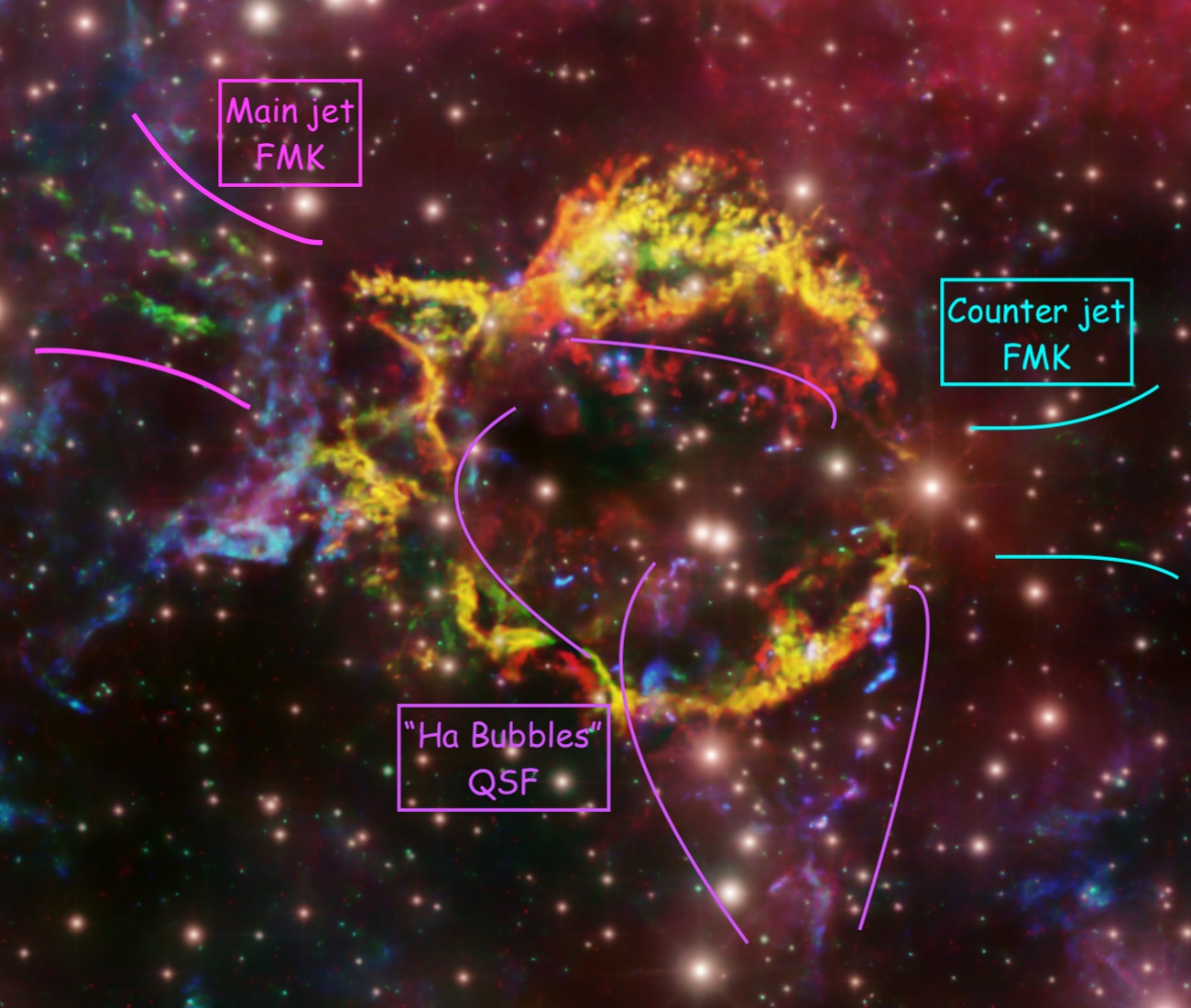 - Outbursts/jets in Cassiopeia A
- Outbursts/jets in Cassiopeia AOne of the surprises we saw in the final stack was the many outbursts/jets we were able to reveal in great detail - something that hasn’t been done by any amateurs before.
Starting in the east (see image), we see the main Jet. While we find a lot of different elements in this jet, in the chosen SHO palette only the Sii is showing within the jet. The jet consists of so-called “Fast moving knots” or FMK, matter ejected from the Supernova (SN) at high speeds.
In the south-east we see a wide type of burst that is also very active in other wavelengths that we aren’t able to image (i.e Fe and Mg emission lines). To our surprise it was also quite well visible in Oiii and Sii, so we still got a detailed look at it. In the west we see the so-called counter jet - as the name suggests it is a counter piece to the main jet. Again, this one was also only visible in Sii. Being a lot fainter and less dense than the main jet we were really happy to have picked it up, even not knowing of its existence in the beginning.
Finally, as already mentioned earlier, we also see the “Ha knots/QSF” all over the place. See the image below to compare our image and an annotated Cas A scheme - you’ll find all the above mentioned features. Note that the “SN blastwave” seems not to be visible in SHO.
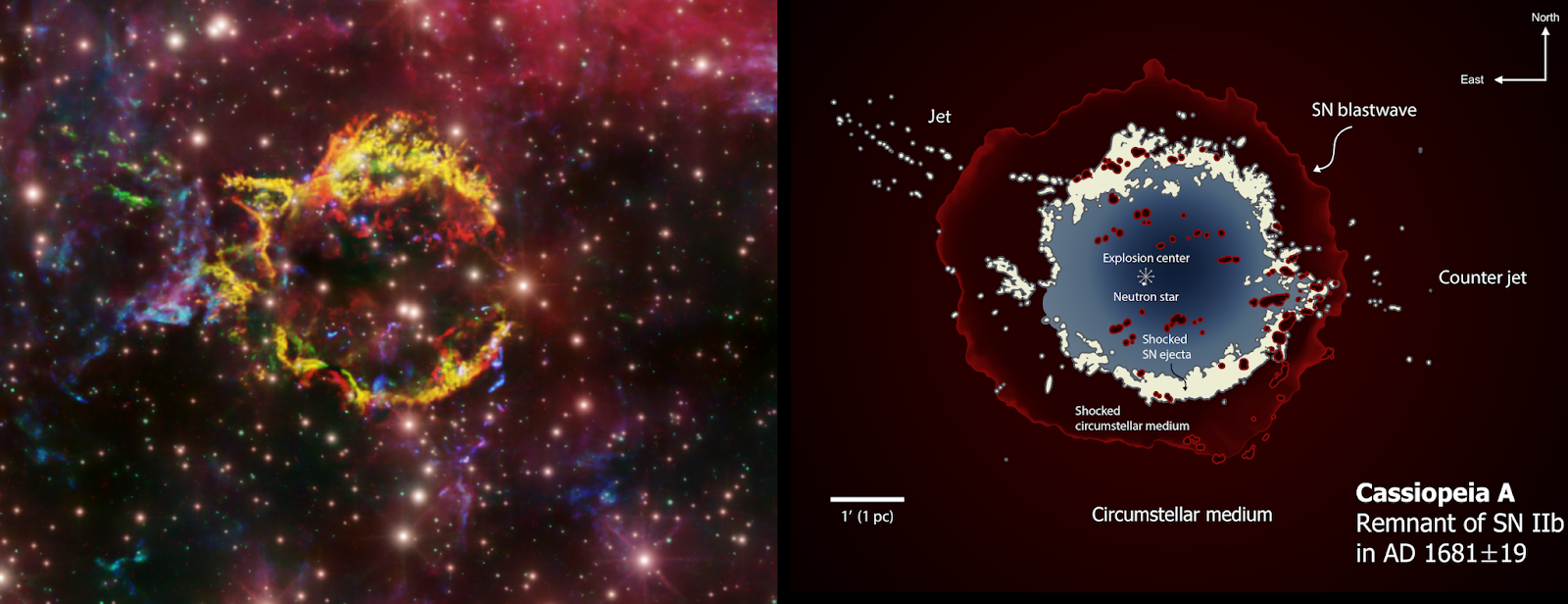 Image on the right: Credit: Handbook of Supernovae, Supernova Remnant Cassiopeia A, 2017, Koo and Park. © Springer- Further components of Cas A
Image on the right: Credit: Handbook of Supernovae, Supernova Remnant Cassiopeia A, 2017, Koo and Park. © Springer- Further components of Cas A Besides being an interesting target in optical light, Cassiopeia A shows various interesting features in other wavelengths as well. For example, while not showing in optical light, the SN blastwave (see photo) mentioned earlier has strong emission lines in high-energy X-Ray wavelengths, making it look even more dynamic. This very SN blastwave has for example been imaged by the Chandra x-ray telescope to conduct further research.
Other than X-Ray, IR (infra-red) has also proven to be interesting for research. In fact, the QSF and FMK are also very pronounced in specific wavelengths in IR (being [Si I] and [Fe II]). In fact, Paul first found out about about the QSF and FMK in Cas A when reading an article written by Prof. Koo and his team - in order to examine the QSF and FMK in Cas A their team did deep integrations on exactly these emission lines and were able to get more insight on them.
Recognizing that these distinctive features in Cas A are observable across various wavelengths, our team collaborated with the Chandra X-Ray team to blend our data. The aim was to generate a comprehensive image showcasing a multitude of captivating emissions in Cas A.
You can find this final combined image under this post as “Revision B”. See below for a low-res version.
Again, big thanks to the Chandra team for providing their data as well as prof. Koo and his team for their insightful paper about Cas A.
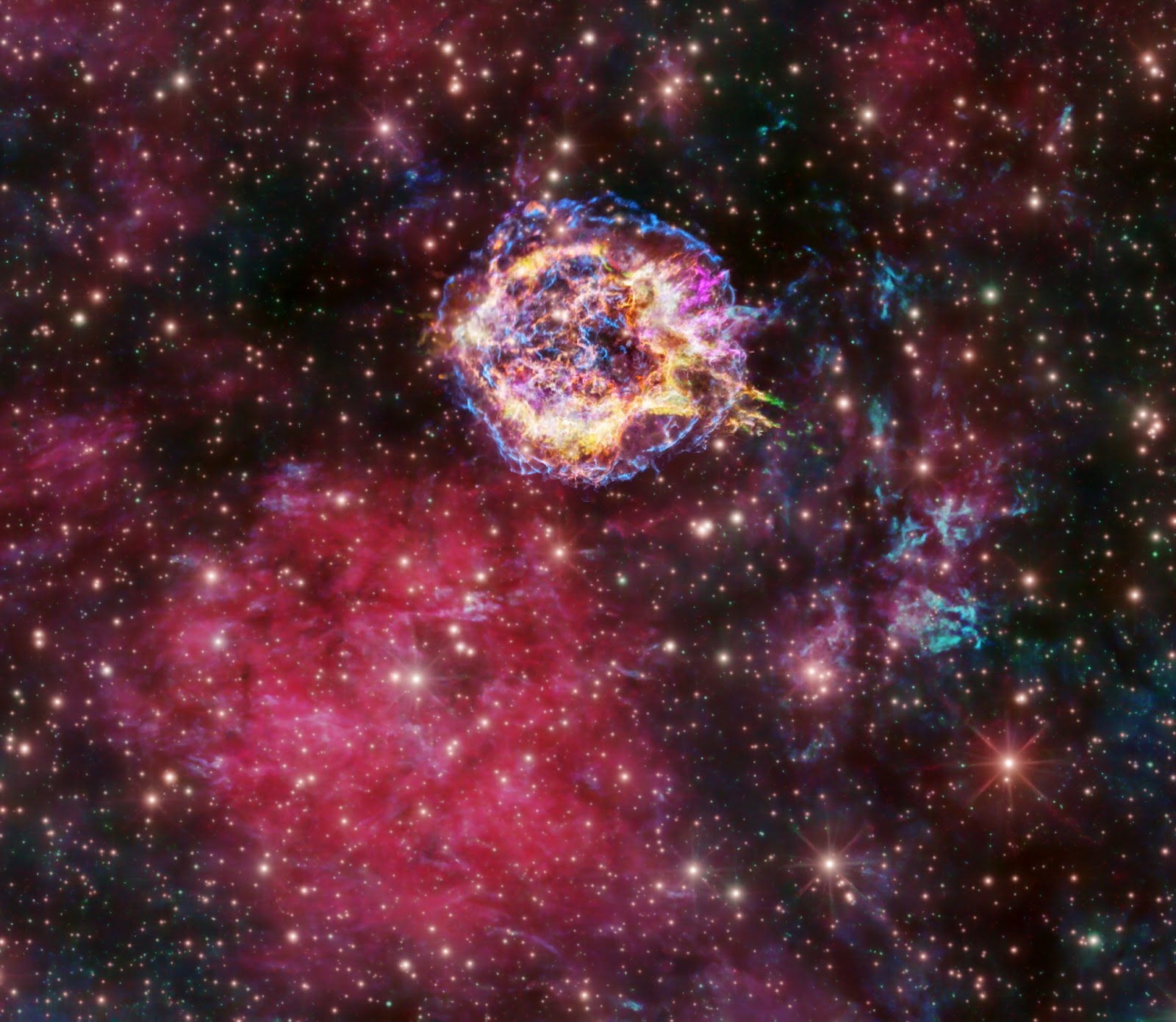 © x-Ray data: NASA Chandra telescope: https://chandra.harvard.edu/index.html- Oiii region near Cas A
© x-Ray data: NASA Chandra telescope: https://chandra.harvard.edu/index.html- Oiii region near Cas ATo the north of Cas A there is a region that is primarily visible in the Oiii wavelength. We couldn’t find further information about this Oiii region and it seems to be an uncatalogued random patch of Oiii. You see this region as the red blob above Cas A.
- Background Ha and filament like structureThis region in the constellation of cassiopeia is very abundant in hydrogen alpha emissions, giving the image a nice filled background. By closer inspection of the image it can be seen that parts of the Ha background seem to consist of filament-like structures which add a lot of dynamic to the image.
Below is the Ha stack with just a STF applied, showing the extreme dynamic in this field.
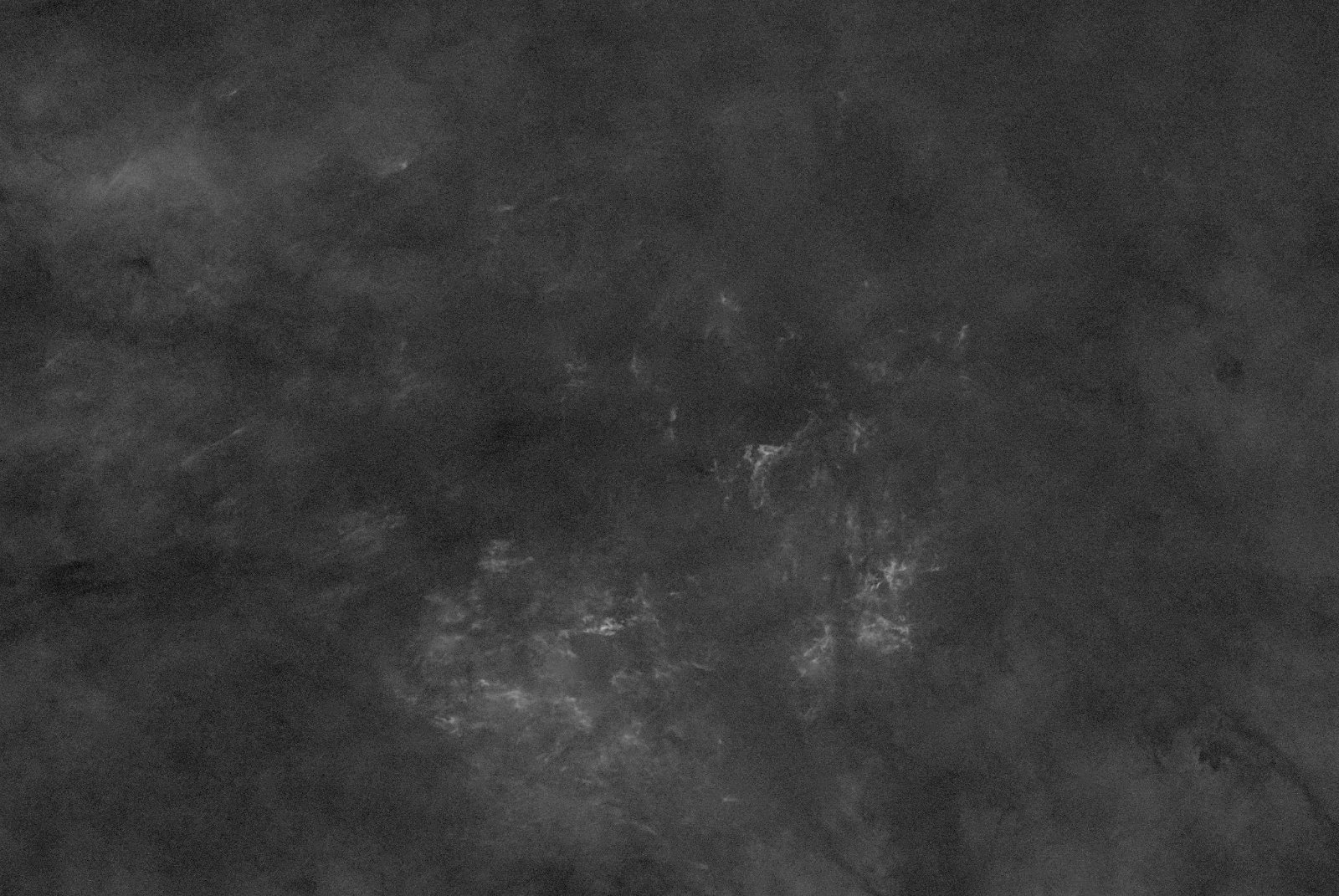 - Paul’s Technical, more in-depth text
- Paul’s Technical, more in-depth text Cas A is believed to have resulted from the Type IIb supernova collapse of a ~15-25 solar mass star (the progenitor). The presence of hydrogen lines in the spectrum of Cas A confirm it generally as a Type II, the addition of weak helium lines further categorise it as the rare Type IIb, and is the result of the core-collapse of a H-envelope stripped massive star consisting of a bare Helium core at the time of collapse. It has left behind a neutron star.
Previous studies of Cas A have been confined to studying the shocked ejecta in optical, IR and X-ray. The shocked material has 3 main components- the 200”-diameter main shell, the jet/counter-jet and diffuse X-ray emitting Fe-rich plumes extending beyond the main shell in the SE, N and W.
Unshocked ejecta also exists, unusually, which preserves the information immediately prior to the explosion. This can be seen in the deep NIR [Fe II] image by Koo, et al. in the region surrounding the explosion centre. The diffuse unshocked emission takes the form of filaments, clumps and arcs, well inside the main ejecta shell. Of most interest here are the sections labelled IDC (Interior Diffuse Clump) 1 and 2, seen in the Deep NIR image of Koo et al. These appear to flank the explosion centre, and lie just south of the jet/counter-jet axis. They are faint but clearly visible in the NIR image, being attributed tentatively to [Si I] emission, rather than the usually bright [Fe II] emission. Of interest here is the mention that this diffuse emission, previously identified in the infrared, has also been detected in [S III], an emission of doubly-ionised Sulphur, rather than the singly-ionised Sulphur of our filters. Given that Sulphur is present in this rarely imaged unshocked component, this prompted a search in our Sulphur image. We believe that there are very faint green areas, in just the right spots, corresponding to IDC 1 and IDC 2. We believe this could be the first detection of unshocked ejecta in the [S II] emission, and certainly the first by amateurs.
Cas A unshocked ejacta.movAnnotated image: J. C. Raymond et al 2018 ApJ 866 128 The Ha knots (blue in our image) are classified as QSFs (Quasi-Stationary Flocculi). Koo, et al. 2018, provides detail on these via their deep near Infrared image at the [Fe II] + [Si I] emission of 1.644 um/1.645um. The QSF’s are mainly Ha emitters, hence why they show up only in the Ha data. These ‘quasi-stationary’ knots have velocities of around 500 km/s. These Ha clumps are mostly confined to the interior of the main shell, with the exception of the SW arc. QSFs in the western area (West is right in Astronomy!) were recently discovered (as of 2018), and we are pleased to have also detected a few of these near the 2 bright stars, but large extinction in the region prevents further detection. These QSFs have a relatively short lifespan, in astronomical terms. Based on analysis on previous images taken over the preceding decades, the lifetime is of the order ~100 years, and most will survive until they interact with the main ejecta shell. The formation history of QSFs seems to be an open question. There is suggestion that these are formed during a mass loss event of a Red Supergiant, or possibly as the result of a luminous red nova in the common envelope phase of a binary system.
See previous images In contrast to the QSFs, present as green dots and streaks, are the FMKs, or Fast Moving Knots. These have velocities around 5000 km/s and appear primarily outside the main shell. They are composed of mainly O and S, and show up primarily in our [SII] data. A total of 1825 FMKs have been identified using multiple filters on HST, and are further subdivided into Nitrogen, Oxygen and Sulphur-rich. Each subcategory has a very different spatial distribution. In our image, the FMKs are all green and predominantly located in the jet structures, indicating we are detecting the S-rich subcategory. We don’t have a Nitrogen filter, although Ha filters with FWHM > 5nm should contain some [N II] signal. That just leaves the O-rich FMKs, which in our image should be red. These are unidentified, perhaps due to a lack of emission in the [O III] of our filters. These are also known to be fewer in number. The predominant FMK feature is the jet/counter-jet. These are undecelerated having been ejected from the innermost region at the time of collapse by a jet-like mechanism. This jet structure also shows as an Fe-rich plume in Chandra X-ray images.
See previous images In conclusion Cas A is an excellent case study for SN physics, and is highly unusual in that it took a long time to be detected. Also unusual is the presence of unshocked ejecta. A complete description is only possible through multi-wavelength studies, as the different wavelength regimes highlight different physical mechanisms, with regular reference to Spitzer mid IR, HST, X-ray and other NIR studies.
In our image specifically, we are pleased to have captured many of the major features of Cas A-the main shell, jets, QSFs and FMKs. We are especially excited to have a possible first detection of [S II] from unshocked ejecta (at least at an amateur level). It’s also clear that SNRs would benefit at an amateur level from additional filters-unfortunately these aren’t readily acquired.
This technical description has relied heavily on the excellent paper of BC Koo, et al. This paper describes all our structures in one paper. We are indebted to Prof Koo for providing the ‘Deep NIR image’ referenced above as well as the Chandra X-ray team for their data.
References:- Information on Type IIb SNe: Kraus et al 2008:
https://arxiv.org/pdf/0805.4557.pdf
- Information on the structures of Cas A: BC Koo, et al 2018:
https://arxiv.org/pdf/1809.07935.pdf- Chandra x-ray observation:
https://chandra.harvard.edu/photo/2017/casa_life/For any further questions about the project, feel free to leave a comment, or write us an e-mail: [email]
[email protected][/email] !
For a more technical overview of the post-processing, please refer to Will’s website:
https://theastroenthusiast.com/casa-processing/If you want to see our image in greater detail, feel free to go to Carl’s website, where the image is uploaded in full resolution ( 6007 x 4021 px), enabling you to explore the picture by yourself and being able to zoom in on every tiny detail, we strongly recommend zooming into the core of Cas A!
Link to his website:
https://elveteek.ch/casa-dscIntegration overviewHere you find a list of integration contributions from all 11 photographers. This was before filtering out bad subs. The actual integration time is given in the second overview chart.
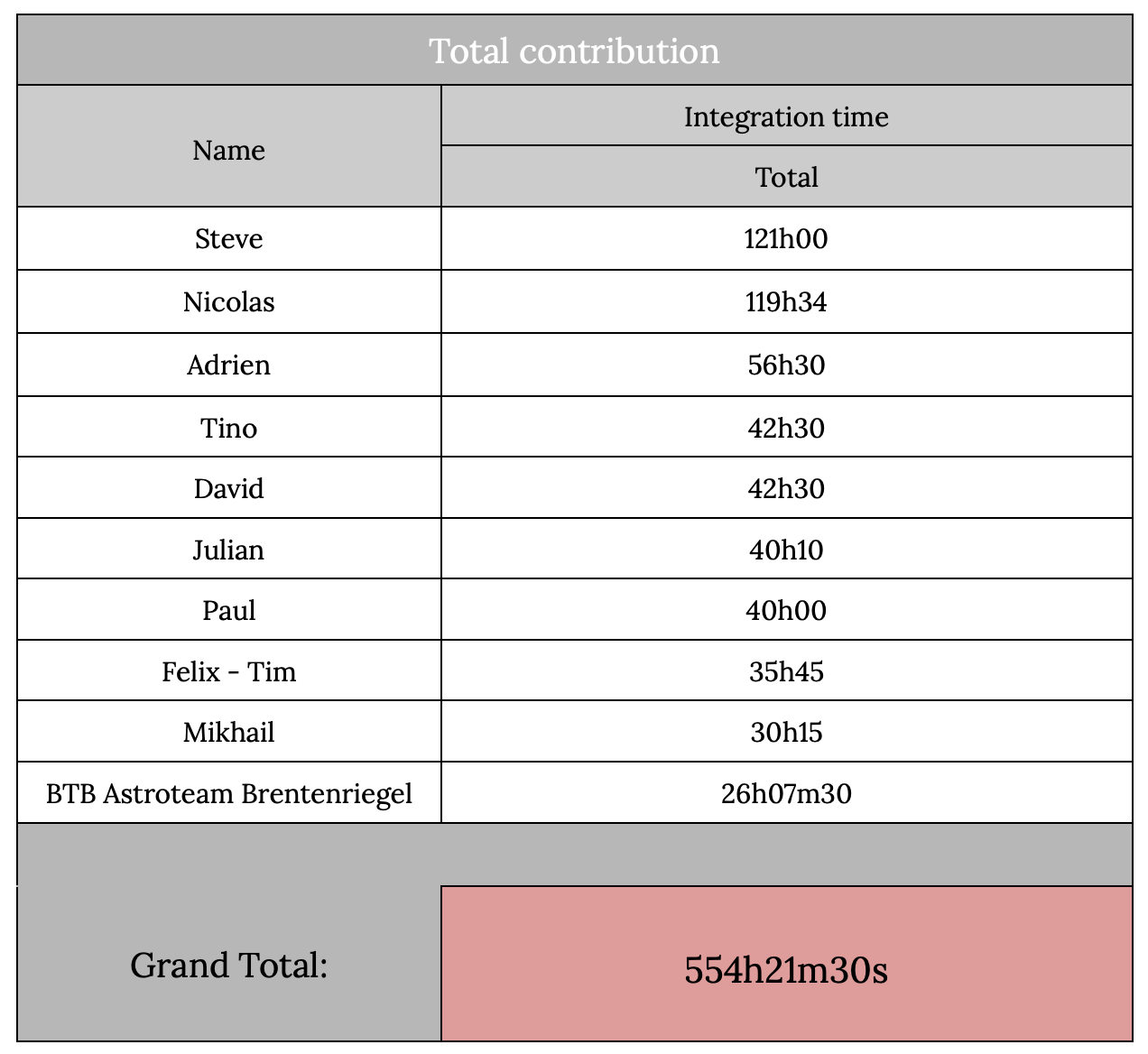
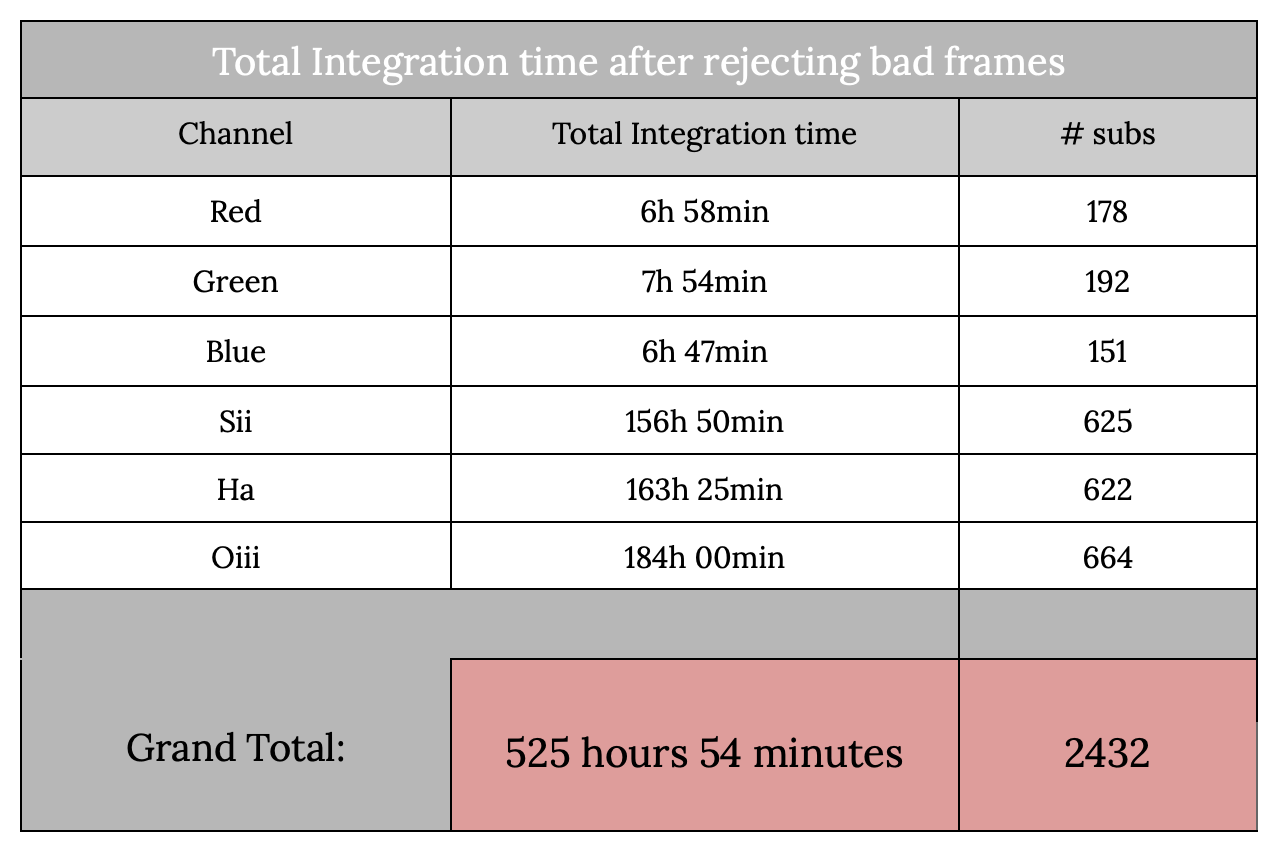
We hope that you enjoy this image!
Text written by
@Tim Schaeffer , co-ordinator of the project with the help of
@Paul Kent who conducted research online and wrote a more technical, in-depth text on the QSF and FMK. Big thanks to him for his time and effort!












Comments